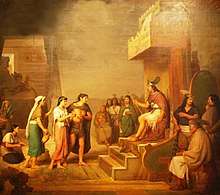Xochitl (Toltec)
| Xochitl | |
|---|---|
| Empress of the Toltecs | |
 | |
| Reign | 877-916 |
| Predecessor | Tecpancaltzin Iztaccaltzin |
| Successor | Cē Ācatl Topiltzin QuetzalCoatl |
| Born |
Before 877 Toltec Empire |
| Died |
916 Toltec Empire |
| Father | Papantzin |
| Mother | Unknown |
| Religion | Toltec religion |
Xochitl (r. 877-916) was a Toltec Queen and wife of Tecpancaltzin Iztaccaltzin. Her existence beyond legend is questionable, and accounts of her life are mainly based on the writings of indigenous historian Fernando de Alva Ixtlilxochitl.
Biography
Xochitl was a mistress of the Toltec Emperor Tecpancaltzin, bearing him a son. (Tecpancaltzin had only daughters by his first wife, Maxio). After Maxio died, Xochitl became recognized as queen.[1] Her son became heir and was known as Topiltzin-Meconetzin.
When she was elderly, civil war erupted in the Toltec Empire. Xochitl called upon other women to join her in battle, and created and led a battalion made entirely of women soldiers. She died on the battlefield.[2] The son of Xochitl and Tecpancaltzin, Topiltzin, was the last of the Toltec kings, before he was overthrown in the civil war. It was during the final stand of the Toltecs at Tultitlan that Tecpancaltzin and Xochitl were slain in battle.[3]
Depiction in art

A well-known painting of Xochitl and Tecpancaltzin, El descubrimiento del pulque, was completed in 1869 by Mexican artist José Obregón. Obregón was trained, and painted in, a classical style popular in the 19th century. El descubrimiento del pulque is based on historian Fernando de Alva Ixtlilxochitl's description of Xochitl as a beautiful virgin brought to Tecpancaltzin by her father, Papatzin. Papatzin was a Toltec noble, and a cultivator of maguey plants, also called agave plants and related to aloe. Xochitl presented to Tecpancaltzin a drink that she and/or her father invented, pulque, made from the honey of maguey. The painting was part of a cultural rise in Mexican nationalism during the period, yet the influence of classical European art symbolism appears throughout the painting. Xochitl is depicted as a Greek princess, and Tecpancaltzin is shown as a "Hellenic Apollo"; Mexico's "Indian past was thus civilized through a classical romantic filter".[4]
More recently, Xochitl appears as one of the 999 women included in American artist Judy Chicago's installation work, The Dinner Party. Xochitl is named in the Heritage Floor.
References
- ↑ Bancroft, Hubert Howe (2009) [1883]. The native races [of the Pacific states] (University of California ed.). A. L. Bancroft & company. p. 270.
- ↑ Salas, Elizabeth (1990). Soldaderas in the Mexican Military: Myth and History. University of Texas Press. p. 3. ISBN 9780292776388.
- ↑ Bancroft, Hubert Howe (2009) [1883]. The native races [of the Pacific states] (University of California ed.). A. L. Bancroft & company. p. 284.
- ↑ Tenorio-Trillo, Mauricio (1996). Mexico at the World's Fairs: Crafting a Modern Nation. Volume 35, The New Historicism: Studies in Cultural Poetics. University of California Press. pp. 119–20. ISBN 9780520202672.